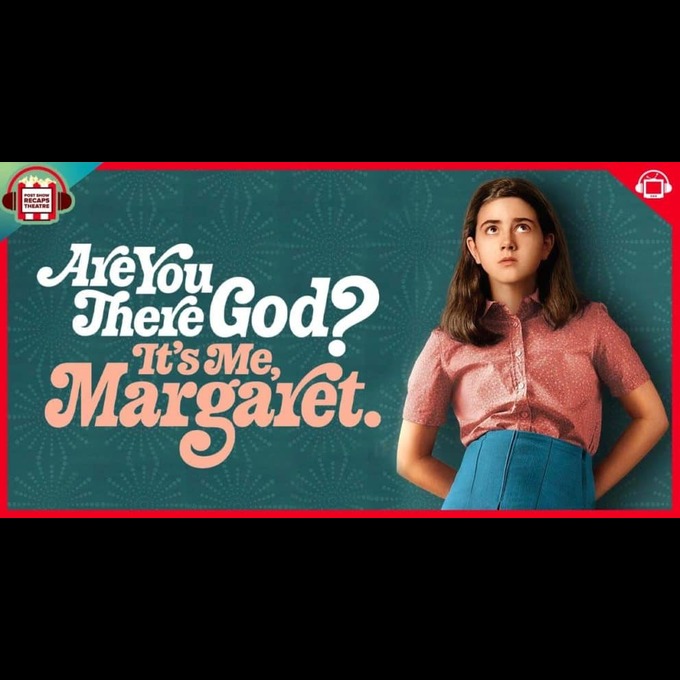Table of Contents
The cast of Are You There God? It’s Me, Margaret (2023):
Main Cast:
Abby Ryder Fortson as Margaret Simon
Rachel McAdams as Barbara Simon
Kathy Bates as Sylvia Simon
Benny Safdie as Herb Simon
Elle Graham as Nancy Wheeler
Amari Alexis Price as Janie Loomis
Katherine Kupferer as Gretchen Potter
Kate MacCluggage as Mrs. Jan Wheeler
Aidan Wojtak-Hissong as Moose Freed
Landon S. Baxter as Evan Wheeler
Echo Kellum as Mr. Benedict
Zackary Brooks as Philip Leroy
Isol Young as Laura Danker
Simms May as Norman Fisher
Mia Dillon as Mary Hutchins
Gary Houston as Paul Hutchins
Supporting Cast:
Olivia Perez as Louise
Melissa Allen as Librarian
John Rubinstein as Rabbi Jaffe
Nancy Travis as Mrs. Appleton
David Paymer as Mr. Appleton
Josh Pais as Dr. Goldfarb
Jane Alexander as Mrs. Goldfarb
Susan Misner as Miss McCarthy
Marilu Henner as Mrs. Gruber
Deborah Rush as Mrs. Wheeler
Richard Schiff as Mr. Wheeler
Mary Beth Peil as Miss Leah
Cameo:
Judy Blume as Woman walking a dog
The plot of Are You There, God? It’s Me, Margaret. (2023)
Eleven-year-old Margaret Simon (Abby Ryder Fortson) is in the throes of pre-adolescence, a whirlwind of changing emotions, budding curiosity, and existential angst. When her family relocates from the bustling city to the serene suburbs of Long Island, Margaret’s familiar world is upended. Suddenly, she’s navigating new friendships, grappling with unfamiliar social dynamics, and confronting the dawning complexities of growing up.
This 2023 adaptation of Judy Blume’s beloved coming-of-age novel, directed by Kelly Fremon Craig, is a poignant and humorous portrayal of Margaret’s internal struggle. We see her through the lens of her daily journal, filled with earnest prayers addressed to a God whose existence she increasingly questions. Her anxieties spiral as she wrestles with self-consciousness about her changing body, the allure and confusion of first crushes, and the pressure to fit in with her new group of friends led by the bold and outspoken Lucy (Benny Safdie).
Also read: Dune Review: A Sci-Fi Epic of Spice, Sandworms & Destiny (2021)
Margaret finds solace in the loving guidance of her mother, Barbara (Rachel McAdams), who navigates her anxieties about motherhood and starting anew in a foreign environment. Their relationship is one of tender vulnerability, shared secrets, and unspoken understandings. Barbara, though struggling with her insecurities, offers unwavering support and encouragement, guiding Margaret through the confusing terrain of adolescence with wit and empathy.
Another pillar of support is Margaret’s grandmother, Sylvia (Kathy Bates), a vibrant and outspoken woman facing her challenges as she embarks on the next chapter of life. Sylvia’s frankness and unconventional worldview serve as a counterpoint to Margaret’s naive wonder, challenging her perception of the world and offering alternative perspectives on societal expectations and faith.
Through their interactions with these women, Margaret begins to understand the complexities of identity. She experiences moments of awkwardness and humiliation, like the infamous underwear-fitting scene at Miss Louise’s store, but also moments of genuine joy and friendship, like the sleepover filled with whispered secrets and daring games.
Amidst the personal turmoil, Margaret grapples with larger questions about faith and belonging. Her interactions with her family, their Catholic and Jewish backgrounds, and the diverse tapestry of her new community expose her to different religious and cultural beliefs. While not providing definitive answers, the film encourages Margaret to question, explore, and form her understanding of spirituality.
The climax arrives with Margaret’s unexpected first period, a milestone tinged with fear and confusion. This transformative event serves as a pivotal moment of self-discovery. With the support of her mother and newfound confidence, Margaret starts to embrace the changes within her, shedding her childhood innocence and stepping into the unknown territory of adolescence.
The film ends on a hopeful note, hinting at the future adventures that await Margaret. As she walks onto the school bus, holding her head high and surrounded by her newfound friends, we see a hint of the strong, independent young woman she’s becoming.
“Are You There God? It’s Me, Margaret.” is not just a coming-of-age story; it’s a universal tale of self-discovery. It beautifully captures the awkwardness, joy, and confusion of pre-adolescence, reminding us of the universal emotions that transcend generations and cultures. The film celebrates the importance of female relationships, the power of self-acceptance, and the journey towards finding one’s place in the world. With its humor, honesty, and heartwarming performances, “Are You There God? It’s Me, Margaret.” reaffirms the timeless message of Judy Blume’s classic novel: that growing up, though messy and unpredictable, is ultimately a beautiful and empowering journey.
The Character Development in Are You There God? It’s Me Margaret (2023)
“Are You There, God? It’s Me, Margaret” (2023) is a rich tapestry of character development, exploring the growth and transformation of several key figures as they navigate the complexities of life and identity. Here’s a closer look at the journeys of some of the main characters:
Margaret Simon:
At the heart of the film, Margaret is an eleven-year-old grappling with the whirlwind of pre-adolescence. As she adjusts to a new town, school, and friends, she encounters confusion about her changing body, anxieties about fitting in, and the looming questions of faith and belonging. Throughout the film, we see Margaret navigate these challenges with a mix of naivety, curiosity, and growing self-awareness. She learns to assert herself, challenge expectations, and embrace her individuality. By the end, she emerges as a more confident and independent young woman, still navigating the unknown but equipped with newfound understanding and self-acceptance.
Barbara Simon:
Margaret’s mother, Barbara, is a complex and relatable figure. She struggles with the anxieties of motherhood, adjusting to a new environment, and her internal conflicts. Yet, she remains an unwavering source of support and guidance for Margaret. Through their conversations, Barbara shares her vulnerabilities and experiences, fostering a deep bond of trust and understanding. As the film progresses, Barbara also embarks on a journey of self-discovery, rediscovering her passions and her voice. Their relationship evolves from parent-child to one of mutual respect and shared growth.
Sylvia Simon:
Margaret’s grandmother, Sylvia, brings a vibrant and unconventional perspective to the film. As a woman facing her challenges in later life, Sylvia challenges societal expectations and traditional views on faith and identity. Her frankness and humor serve as a counterpoint to Margaret’s innocence, encouraging her to question assumptions and explore different viewpoints. Through their interactions, Sylvia instills in Margaret a sense of independence and encourages her to be true to herself.
Nancy Wheeler:
Margaret’s first true friend, Nancy, is a whirlwind of energy and enthusiasm. Initially drawn to Nancy’s confidence and boldness, Margaret soon learns that beneath the surface, Nancy grapples with her own insecurities and anxieties. Their friendship serves as a crucible for growth, as they learn to navigate peer pressure, betrayal, and the complexities of growing up together. Ultimately, their bond evolves beyond the initial allure of popularity, showcasing the importance of understanding and acceptance.
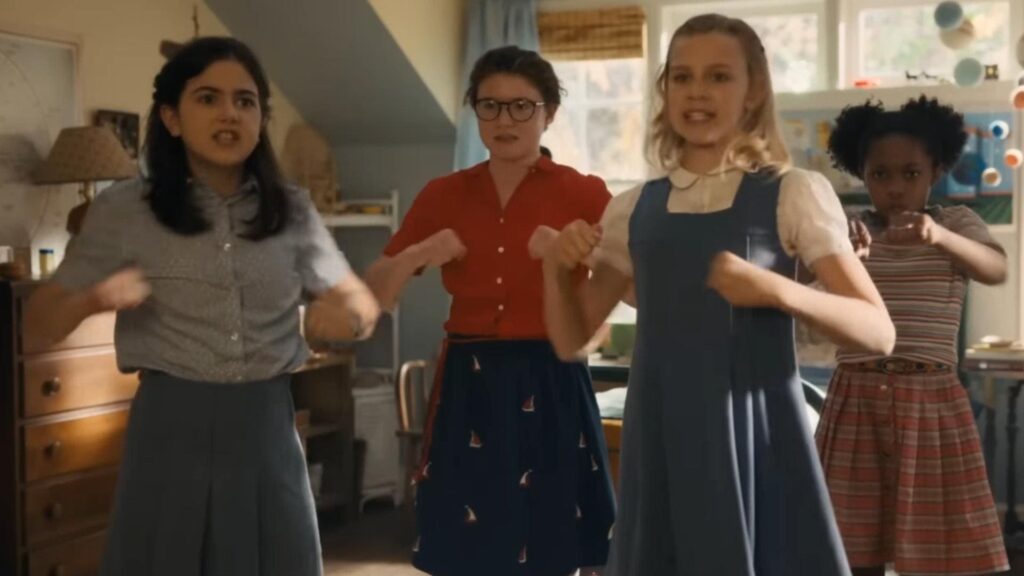
These are just some of the characters who undergo significant transformations in “Are You There God? It’s Me, Margaret.” The film’s beauty lies in its nuanced portrayal of their journeys, showcasing the messy, unpredictable, and ultimately rewarding process of self-discovery. Each character grapples with personal challenges, societal pressures, and their own evolving sense of self, making their development relatable and emotionally resonant for audiences of all ages.
Also read: The Killer (2023): Brutality and Beauty Dance in Fincher’s Latest Thriller
Overall, “Are You There God? It’s Me, Margaret” is a heartwarming and insightful film that celebrates the complexities of growing up. By delving into the character development of its protagonists, the film reminds us that the journey of self-discovery is a continuous one, filled with joy, confusion, and ultimately, the beauty of becoming who we are meant to be.
The Themes in Are You There God? It’s Me Margaret (2023)
With its timeless coming-of-age narrative, “Are You There God? The book “It’s Me, Margaret” (2023) explores various themes that are important for teenagers and beyond. Here’s a closer look at some of the film’s most prominent themes:
1. Coming-of-Age: At its core, the film chronicles Margaret’s journey through pre-adolescence, a whirlwind of physical and emotional changes, budding curiosity, and self-discovery. We witness her grappling with her changing body, first crushes, the pressures of fitting in, and the dawning awareness of her own mortality. Each milestone, from the awkwardness of buying her first bra to the confusion of her first period, serves as a stepping stone on her path to becoming a young woman.
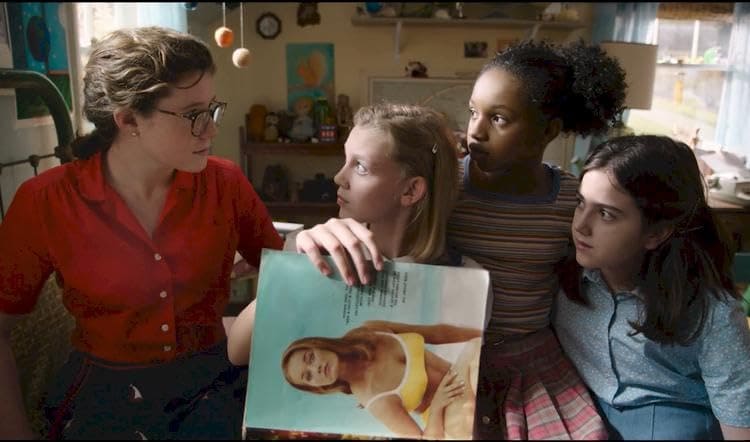
2. Family and Friendship: The film portrays the vital role of family and friendship in navigating the challenges of growing up. Margaret’s loving yet complex relationship with her mother, Barbara, provides a bedrock of support and guidance. Their honest conversations and shared vulnerability deepen their bond and offer Margaret a safe space to explore her anxieties. Similarly, her evolving friendship with Nancy, despite its rocky moments, teaches her valuable lessons about trust, empathy, and the importance of genuine connection.
3. Faith and Doubt: Raised in an interfaith household, Margaret grapples with questions about faith and spirituality. Through her conversations with her family and encounters with different religious beliefs, she begins to form her understanding of the world and her place in it. The film encourages open-mindedness and exploration, acknowledging the complexities of faith and the individual journey of finding meaning.
4. Identity and Self-Acceptance: Throughout the film, Margaret embarks on a journey of self-discovery. She challenges societal expectations, confronts her insecurities, and learns to embrace her individuality. By the end, she emerges with a stronger sense of self-confidence and acceptance, understanding that who she is and what she believes in are ultimately up to her.
5. Gender and Body Image: “Are You There God? “It’s Me, Margaret” honestly and sensitively discusses sensitive subjects like gender and body image. Margaret and her friends navigate the changes in their bodies, societal pressures related to beauty standards, and the insecurities that come with them. The film encourages positive self-image and celebrates girls for who they are, not just how they look.
These are just some of the rich themes explored in “Are You There God? It’s Me, Margaret.” By weaving these universal narratives into the story of a young girl’s journey, the film resonates with audiences of all ages, prompting reflection on themes of identity, growth, and the enduring power of human connection.
The Direction in Are You There God? It’s Me Margaret (2023)
Kelly Fremon Craig’s Vision: Bringing Judy Blume’s Classic to Life
The 2023 adaptation of Judy Blume’s beloved novel “Are You There God? It’s Me, Margaret.” owes much of its success to the skillful direction of Kelly Fremon Craig. Craig, known for her work on the coming-of-age comedy-drama “The Edge of Seventeen,” brings a nuanced and sensitive touch to Margaret’s journey, capturing the humor, awkwardness, and emotional honesty of pre-adolescence.
1. A World Through Margaret’s Eyes:
Craig’s direction puts us firmly in Margaret’s shoes. The camera often adopts her perspective, framing scenes from her height and showcasing her curiosity and wonder. This intimate approach allows us to experience the world as she does, feeling the excitement of new friendships, the sting of social exclusion, and the confusion of burgeoning emotions.

2. Balancing Humor and Heartbreak:
Craig expertly balances the film’s comedic elements with its more poignant moments. The awkwardness of puberty, from first crushes to embarrassing encounters, is handled with lightheartedness and understanding. However, Craig also delves into deeper themes like family dynamics, faith, and self-discovery with emotional honesty, drawing out genuine laughter and tears from the audience.
3. Performances that Shine:
Craig’s direction elicits stunning performances from her cast. Abby Ryder Fortson captures Margaret’s vulnerability and resilience with remarkable nuance. Rachel McAdams delivers a layered portrayal of Barbara, a mother battling her own anxieties while supporting her daughter. Kathy Bates adds humor and wisdom as Sylvia, Margaret’s unconventional grandmother.
4. Visual Storytelling:
Craig utilizes visual cues to enhance the film’s emotional impact. The use of light and color subtly reflects Margaret’s changing moods and internal conflicts. The cinematography is both nostalgic, capturing the warmth of 1960s suburbia, and contemporary, resonating with audiences of all ages.
5. A Tapestry of Experiences:
Ultimately, Craig’s direction transforms “Are You There God? It’s Me, Margaret.” into a tapestry of experiences, both universal and deeply personal. The film captures the essence of being eleven, with all its joys, anxieties, and discoveries. It is a testament to Craig’s skill that she brings Blume’s timeless story to life in a way that feels fresh, relatable, and emotionally resonant for audiences of all generations.
In conclusion, Kelly Fremon Craig’s direction is a critical element of the film’s success. Her nuanced approach, skillful storytelling, and ability to elicit powerful performances from her cast elevate “Are You There God? It’s Me, Margaret.” from a classic novel adaptation to a heartwarming and enduring cinematic experience.
The Cinematography of Are You There God? It’s Me, Margaret (2023)
The 2023 adaptation of Judy Blume’s “Are You There God? It’s Me, Margaret.” isn’t just a coming-of-age story; it’s a visual journey through the kaleidoscope of emotions and experiences that define pre-adolescence. Cinematographer Greta Zozula plays a crucial role in this, crafting a unique visual language that mirrors Margaret’s perspective and enhances the film’s emotional impact.
1. A World in Bloom:
Zozula bathes the film in a warm, nostalgic glow, reminiscent of the golden hues of a 1960s summer. Sun-drenched lawns, vibrant summer dresses, and the lush greenery of suburban Long Island create an idyllic backdrop for Margaret’s childhood adventures. This visual aesthetic captures the innocence and wonder of her initial exploration of the world.
2. Intimate Framing:
Zozula often places the camera low to the ground, mimicking Margaret’s perspective. This close-up approach draws us into her world, emphasizing her smallness amidst the vastness of adult experiences. Tight handheld camerawork during moments of excitement or anxiety reflects the emotional turbulence within her.
3. Light and Shadow:
Zozula plays with light and shadow to subtly represent Margaret’s internal struggles. Brightly lit scenes showcase moments of joy and discovery, while shadows creep in during periods of confusion or doubt. This visual metaphor heightens the emotional resonance of key scenes, like Margaret’s first encounter with menstruation, where the stark contrast between light and shadow reflects the confusion and anxiety she experiences.
4. Evolving Color Palette:
As the film progresses and Margaret matures, the color palette subtly shifts. The initial vibrant hues gradually give way to softer, more muted tones, mirroring her changing world and growing self-awareness. This visual evolution underscores the film’s message of transformation and acceptance.
5. Symbolism through Cinematography:
Zozula incorporates subtle visual symbols to enrich the narrative. Recurring motifs like butterflies and mirrors hint at Margaret’s metamorphosis and self-discovery. The frequent use of reflections in windows and mirrors visually represents her introspective nature and her journey of understanding herself.
Overall, Zozula’s masterful cinematography elevates “Are You There God? It’s Me, Margaret.” to a visually stunning and emotionally resonant experience. By carefully crafting each shot, she creates a world that is both idyllic and real, mirroring the complexities of pre-adolescence and celebrating the journey of self-discovery.
The Music in Are You There God? It’s Me, Margaret. (2023)
The 2023 adaptation of Judy Blume’s iconic novel, “Are You There God? It’s Me, Margaret,” isn’t just a visual and emotional feast; it’s also a sonic treasure trove. Composer Nathan Barr crafts a meticulously layered soundtrack that enhances the film’s themes and complements Margaret’s journey of self-discovery.
1. Capturing the Era:
Barr weaves in nostalgic tunes from the late 1960s, evoking the era in which the film is set. Upbeat pop tracks like The Supremes’ “Stop! In the Name of Love” and Lesley Gore’s “It’s My Party” play during carefree moments with friends, transporting us back to a simpler time.
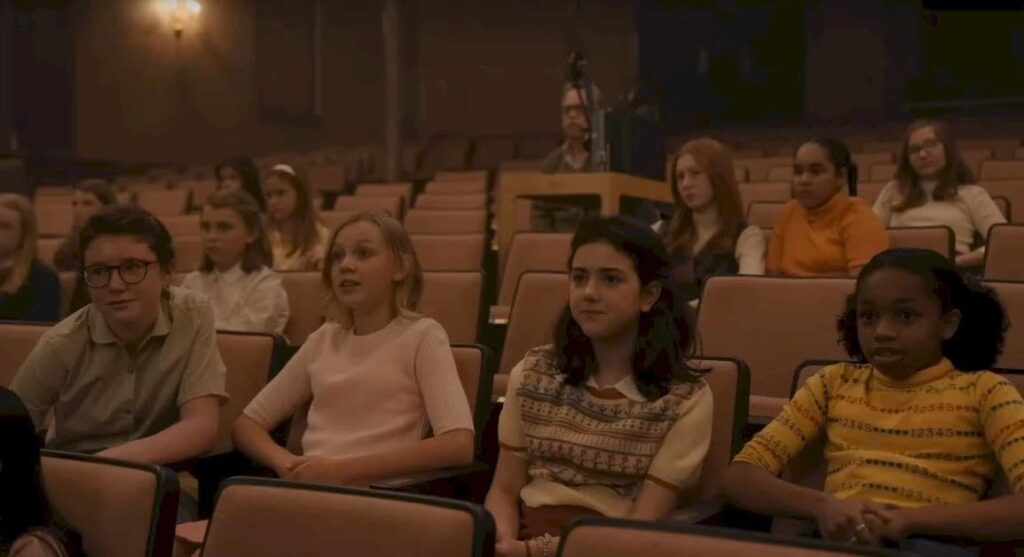
2. Reflecting Emotions:
The music isn’t merely background noise; it actively reflects Margaret’s emotional state. Gentle piano melodies accompany introspective moments of self-discovery, while playful xylophone tunes add lightness to scenes of youthful escapades. Poignant orchestral swells underscore moments of emotional upheaval, like Margaret’s first period, making the music an integral part of the storytelling.
3. A Touch of Modernity:
While rooted in the 1960s, the soundtrack avoids sounding dated. Barr subtly infuses contemporary orchestral arrangements and electronica flourishes, creating a timeless tapestry that resonates with both older and younger generations. This blend of vintage and modern elements reflects Margaret’s own journey – bridging the gap between childhood and adolescence.
4. Theme Songs and Leitmotifs:
The film features two original theme songs: “Are You There God?” and “It’s Me, Margaret,” both performed by rising singer-songwriter, Olivia Rodrigo. These catchy tunes capture the film’s essence, with “Are You There God?” expressing the uncertainty and search for answers that defines Margaret’s journey, while “It’s Me, Margaret” celebrates her growing confidence and self-acceptance. Additionally, Barr utilizes recurring leitmotifs throughout the score, associating certain melodies with specific characters or emotions, deepening the emotional connection with the audience.
5. The Power of Silence:
Just as important as the music itself is the strategic use of silence. Moments of contemplation and emotional vulnerability are often punctuated by quiet pauses, allowing the weight of the scene to resonate without any external influence. This masterful interplay between sound and silence adds another layer of complexity and emotional depth to the film.
Overall, Nathan Barr’s music in “Are You There God? It’s Me, Margaret.” is much more than just a soundtrack; it’s an essential storytelling tool. Its blend of nostalgia, emotional resonance, and contemporary touches perfectly mirrors Margaret’s journey of self-discovery, making the film a truly immersive and unforgettable experience.
Personal Opinion on Are You There God? It’s Me Margaret (2023)
As someone who devoured Judy Blume’s classic coming-of-age novel at the tender age of eleven, revisiting the story through the 2023 film adaptation, “Are You There God? It’s Me, Margaret,” was an experience laced with nostalgia and sweet poignancy. Director Kelly Fremon Craig takes us back to the sun-drenched suburbs of Long Island in the 1960s, where eleven-year-old Margaret Simon (the delightful Abby Ryder Fortson) grapples with the awkward, hilarious, and often confusing rollercoaster of pre-adolescence.
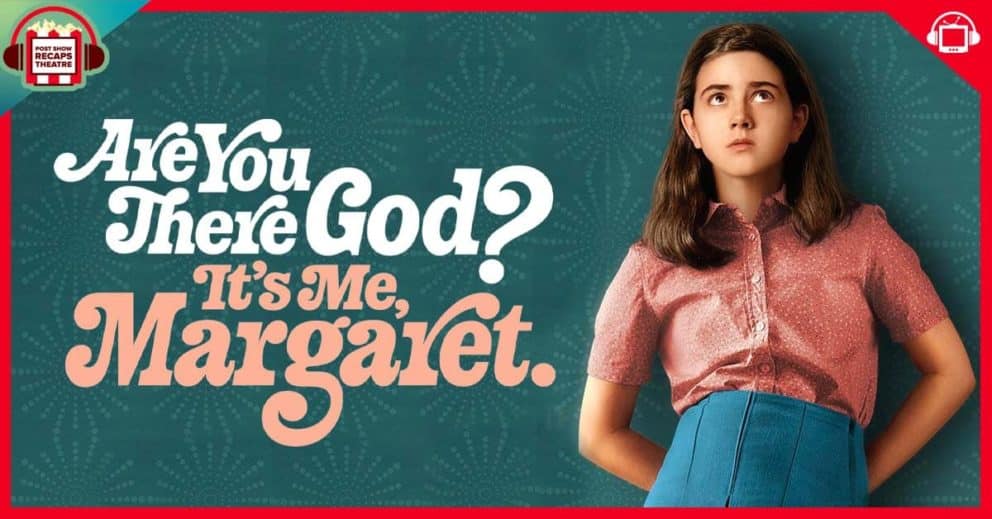
What shines through in this adaptation is its unflinching honesty. Margaret’s journey is messy and relatable, filled with anxieties about changing bodies, first crushes, and the constant pressure to fit in. We see her wrestle with questions about faith, family, and identity, mirroring the universal struggles of every young person on the cusp of adulthood.
The film isn’t just a nostalgic trip down memory lane; it resonates deeply with modern audiences struggling with similar issues. The themes of self-acceptance, embracing individuality, and navigating complicated family dynamics feel as relevant today as they did in the 1960s.
Craig’s direction is masterful, capturing the innocence and wonder of childhood alongside the anxieties and vulnerabilities of pre-adolescence. The film beautifully navigates the balance between humor and heartbreak, making you laugh out loud one moment and shed a tear the next.
The performances are uniformly excellent, with Fortson embodying Margaret’s spirit with a mix of vulnerability and sass. Rachel McAdams delivers a nuanced portrayal of Barbara, Margaret’s loving yet complex mother, and Kathy Bates brings her signature wit and warmth to the role of Sylvia, Margaret’s unconventional grandmother.
The film’s visual palette is a delight, with sun-drenched lawns, vibrant summer dresses, and the lush greenery of suburbia creating a nostalgic backdrop for Margaret’s adventures. The music, a blend of vintage pop tunes and contemporary orchestral arrangements, perfectly complements the story and evokes the emotions of the era.
While some purists might argue that the film deviates from the novel in certain aspects, I believe Craig has successfully adapted Blume’s timeless story for a modern audience. The core themes of self-discovery, friendship, and navigating the complexities of family remain intact, and the film offers a fresh perspective on the challenges and joys of growing up.
“Are You There God? It’s Me, Margaret.” is more than just a coming-of-age story; it’s a reminder of the universal struggles and triumphs of adolescence. It’s a film that celebrates the messy beauty of growing up, the importance of self-acceptance, and the enduring power of family and friendship. Whether you’re a seasoned Blume fan or a newcomer to the story, this film is sure to resonate with its humor, honesty, and heartwarming message.
I highly recommend it to anyone who ever grappled with the trials and tribulations of pre-adolescence, or simply anyone seeking a heartfelt and humorous journey back to a simpler time. Just be prepared to be transported back to those awkward pre-teen years, complete with all the butterflies, anxieties, and newfound freedoms that come with that time.
FAQs about “Are You There God? It’s Me, Margaret.” (2023):
1. How does the film differ from the original novel?
While capturing the essence of Judy Blume’s beloved novel, the film takes some creative liberties. It condenses the timeline, focusing on Margaret’s first summer in Long Island instead of covering multiple years. Certain characters, like Margaret’s brother Tommy, are absent, while others like Nancy Wheeler receive more fleshed-out roles. The film also subtly updates certain aspects to resonate with a modern audience, like Margaret’s conversations about body image and gender roles.
2. Does the film address the book’s controversial topics?
Yes, the film tackles the book’s sensitive themes of menstruation, puberty, and religious exploration head-on. However, it does so with delicate honesty and age-appropriate humor. Margaret’s questions about faith and her changing body are handled openly and without judgment, reflecting the film’s commitment to portraying pre-adolescence authentically.
3. Is the film appropriate for all ages?
While the film avoids graphic content, it deals with themes that might be uncomfortable for younger viewers. Parents should be aware of discussions about menstruation, puberty, and religious differences before deciding if it’s suitable for their children.
4. What are the film’s standout performances?
The young cast delivers phenomenal performances, with Abby Ryder Fortson capturing Margaret’s vulnerability and resilience with remarkable nuance. Rachel McAdams shines as Barbara, Margaret’s loving yet complex mother, and Kathy Bates adds humor and wisdom as Sylvia, Margaret’s unconventional grandmother.
5. Is there a post-credits scene?
No, the film ends with Margaret walking onto the school bus, surrounded by her friends and looking towards the future. This open-ended conclusion leaves room for personal interpretation and allows viewers to reflect on Margaret’s journey of self-discovery.
6. Where can I find the hidden Judy Blume cameo?
Eagle-eyed viewers will spot Judy Blume herself making a brief appearance as a woman walking a dog in the park scene with Margaret and Nancy. This fun Easter egg is a tribute to the author and her timeless story.
